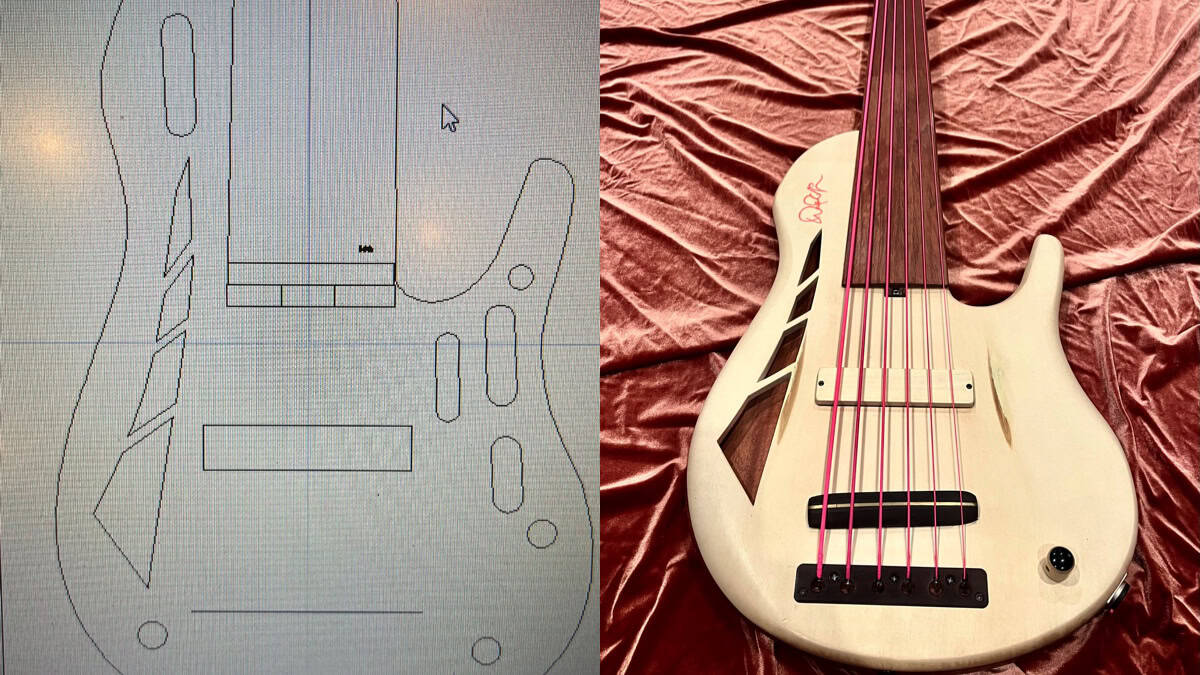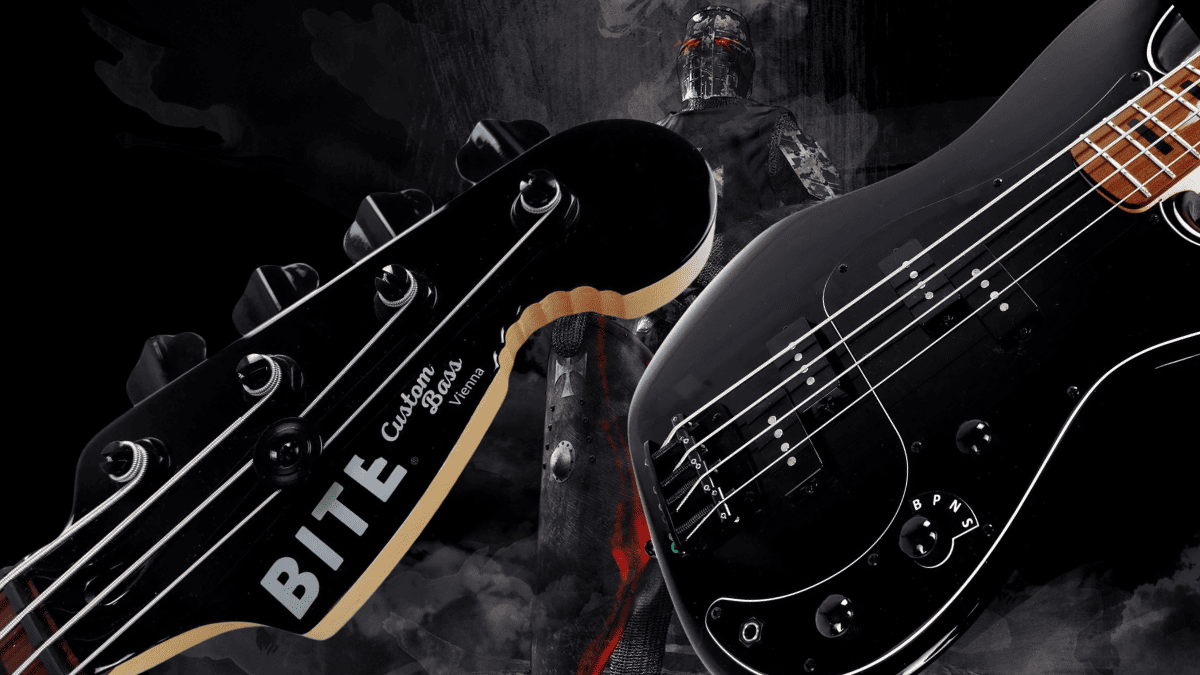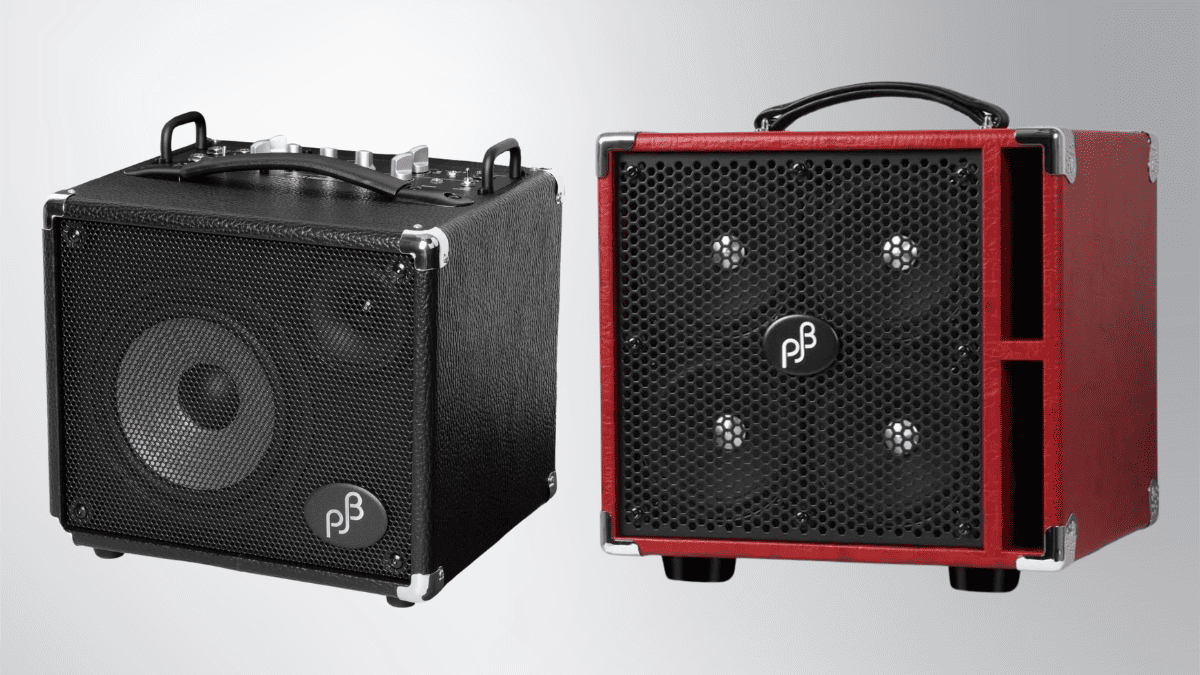Gear Reviews
Bass Review – De Gier BeBop 5 by Jake Wolf

- Alder body
- Maple neck
- Rosewood fingerboard
- 34” Scale length
- 19mm string spacing
- Antique ‘Relic’ finish
- Custom Jason Lollar pickups
- Passive tone control (push/pull for modern/vintage taper)
- De Gier/Vanderkley ‘Fatboost’ control
- Vintage narrow fret wire
- ETS bridge
- Hipshot hardware
The Netherlands may be known for a lot of exciting things, but most of us stateside low-enders would agree that custom exotic basses are not one of them. But De Gier Guitars and Basses, hand built by Sander De Gier in the Netherlands, craft a variety of vintage inspired guitars and basses, as well as some beautiful and exotic models of modern design. This particular BeBop 5 jazz bass landed in my lap for review after some conversation with De Gier, and I’ve been trying to put it down since the day it arrived. It comfort, playability and good looks are fairly addictive. For one thing, this BeBop features an optional relic’ing package to simulate age and wear that is tasteful and artistic. Not to be confused with ‘road wear’, the BeBop’s vintage white alder body appears to have finish checking all over, and the neck has a burnished, broken in vibe that feels super comfortable, with a few intentional bumps and nicks for simulated playing wear. Even the Lollar pickups and ETS hardware look a few decades old, thanks to some tasteful and artistic tarnishing. This is BeBop #79, and it includes the latest modifications to the design, such as a slightly thicker headstock for increased mass, a 7.25”-12” compound fingerboard radius, slightly thinner body, and a more radical belly contour for comfort. It also features a dual function passive tone control that we’ll dig into in a moment. The BeBop had meticulous fretwork and played beautifully with low action. The narrow vintage frets felt great under the fingers, perfectly seated in a gorgeous rosewood board. The truss rod is accessed by removing the pickguard, but the Bebop can be ordered with a pickguard slot routed out for easy standard access. It’s also worth mentioning that there is no surface routing for the pickup wires or electronics, It’s designed so that one can remove the pickguard for a more unfettered and modern jazz bass look.
De Gier’s BeBop can be ordered in a couple of different standard configurations, including any combination of alder or ash body, rosewood or maple fingerboard, 60’s or 70’s pickup placement, Fralin, Nordstrand, or Lollar pickups. This bass came with the custom Lollar pickups, which I just love for their raw and robust tone. The electronics package on the BeBop is a very elegant and hip combination of passive simplicity and modern flexibility: It is a standard volume/volume/tone setup, but things get a bit deeper from there. The tone pot is push/pull, selecting two distinctly different passive tone rolloff tapers, courtesy of both a standard 0.47 cap and the 0.22 vintage cap, that offers a more burp-y vintage tone when rolled off, especially with the bridge pickup solo’d. It’s a very hip, innovative, and above all else, useful feature. Finally we come to the ‘Fatboost’ control, via the 4th knob that works as an on/off switch. Designed in collaboration with Dutch amp builder Vanderkley, This little beauty is a very subtle but effective boost circuit, which (in my own words) plumps up the low end nicely while adding a slight touch of sheen to the top end. Nothing crazy or extreme going on here, just a subtle shift in tonality bringing it just slightly out of the passive feeling/sounding realm. It offers up to 6db of boost via a trim pot in the cavity, and sounds very natural, to my ears. When off, it is true bypass for a 100% passive sound. I really like the ‘Fatboost’s tone and had it engaged for about 90% of the time I played the Bebop.
So I played this bass a lot while it was here for review. I found its vintage aesthetics and modern design sensibilities totally appealing, and combined with its great playability and fabulous tone, it was just addictive. The BeBop sounded great in a band context; the Lollar pickups with the Fatboost served up a raw, full and meaty tone, that filled out the midrange spectrum beautifully while providing a big supportive bottom and a surprisingly (for an alder/rosewood bass) snappy top end, with just enough snarl and grit on hand when you dig in. Being able to access both a “standard” passive tone control, and one that retained much of its midrange fullness when rolled off was immensely versatile, and is a tonal option not found on most other jazz style instruments. The bass arrived with R. Cocco nickel strings, which felt great and sounded warm and full, with a nice amount of snap. I tried a set of medium gauge DR Hi-Beams on the bass (my handy reference point), and found that the BeBop indeed has a lot of inherent grind and snap, with a remarkably muscular slap tone for an alder/rosewood bass, and its ample midrange complexity helps it sit very comfortably in a busy mix.
It seems like there is an exhausting variety of “boutique jazz basses” on the market these days, and one could easily be overwhelmed by the seemingly endless options and array of choices. As I sat playing the De Gier, it felt like no other jazz bass I’ve played: Very sleek and refined, but with a distinctive and unmistakable vintage feel. The BeBop feels like your favorite 10 year-old recliner, or an old pair of comfy slippers. Its tone profile lies squarely within the vintage Fender wheelhouse, but its unique electronics package expands within that wheelhouse, and allows for a surprising range of tones, all of them compelling, inspiring, and usable. As many builders are following the obvious trend these days to blend ‘vintage feel and mojo’ with modern refinement in one way or another, very few, in my opinion, do it with the elegance and gusto of the BeBop.
For more information, visit De Gier guitars on the web at degierguitars.com/bebop
Gear
New Joe Dart Bass From Sterling By Music Man

Sterling by Music Man introduces the Joe Dart Artist Series Bass (“Joe Dart”), named after and designed in collaboration with the celebrated Vulfpeck bassist.
Above photo credit: JORDAN THIBEAUX
This highly-anticipated model marks the debut of the Dart bass in the Sterling by Music Man lineup, paying homage to the Ernie Ball Music Man original that all funk players know and love. The bass embodies many of the original model’s distinctive features, from its iconic minimalist design to the passive electronics.

The design process prioritized reliability, playability, and accessibility at the forefront. Constructed from the timeless Sterling body, the Dart features a slightly smaller neck profile, offering a clean tone within a comfortable package. The body is crafted from soft maple wood for clarity and warmth while the natural finish emphasizes the simple yet unique look.
Engineered for straightforward performance, this passive bass features a ceramic humbucking bridge pickup and a single ‘toaster’ knob for volume control. Reliable with a classic tone, it’s perfect for playing in the pocket. The Dart is strung with the all-new Ernie Ball Stainless Steel Flatwound Electric Bass Strings for the smoothest feel and a mellow sound.

The Sterling by Music Man Joe Dart Bass is a special “Timed Edition” release, exclusively available for order on the Sterling by Music Man website for just one month. Each bass is made to order, with the window closing on May 31st and shipping starting in November. A dedicated countdown timer will indicate the remaining time for purchase on the product page. Additionally, the back of the headstock will be marked with a “2024 Crop” stamp to commemorate the harvest year for this special, one-of-a-kind release.
The Joe Dart Bass is priced at $399.99 (MAP) and can be ordered globally at https://sterlingbymusicman.com/products/joe-dart.
To learn more about Joe Dart, visit the official Vulfpeck artist site here https://www.vulfpeck.com/.
Gear Reviews
The Frank Brocklehurst 6-String Fretless Bass Build

A few months ago, my Ken Bebensee 6-string fretted bass needed some TLC. You know, the one rocking those Pink Neon strings! I scoured my Connecticut neighborhood for a top-notch luthier and got pointed to Frank Brocklehurst, F Brock Music. He swung by my place, scooped up the bass, and boom, returned it the next day, good as new. Not only that, he showed up with a custom 5-string fretted bass that blew me away. I couldn’t resist asking if he could whip up a 6-string fretless for me.
Alright, let’s break down the process here. We’ve got our raw materials: Mahogany, Maple, and Holly. Fun fact – the Mahogany and Maple have been chilling in the wood vault for a solid 13 years. Frank is serious about his wood; they buy it, stash it away, and keep an eye on it to make sure it’s stable.
First up, they’re tackling the Mahogany. Frank glues it together, then lets it sit for a few days to let everything settle and the glue to fully dry. After that, it’s onto the thickness planer and sander to get it nice and flat for the CNC machine. The CNC machine’s the real star here – it’s gonna carve out the body chambers and volume control cavity like a pro.
While the Mahogany’s doing its thing, Frank goes onto the neck core. Three pieces of quartersawn maple are coming together for this bad boy. Quartersawn means the grain’s going vertical. He is also sneaking in some graphite rods under the fingerboard for stability and to avoid any dead spots. The truss rod is going to be two-way adjustable, and the CNC machine’s doing its magic to make sure everything’s just right.
Now, onto the design phase. Frank uses CAD software to plan out the body shape, neck pocket, chambering, and those cool f-holes. I had this idea for trapezoid F-holes, just to do something different. The CAD software also helps us map out the neck shape, graphite channels, and truss-rod channel with pinpoint accuracy.

Once everything’s planned out, it’s CNC time again. Frank cuts out the body outline, neck pocket, and the trapezoid F-holes. Then it’s a mix of hand sanding and power tools to get that neck just how we like it. Oh, and those f holes? We’re going for trapezoids of different sizes – gotta keep things interesting.
Next step: gluing that neck into the pocket with some old-school hide glue. It’s got great tonal transfer and can be taken apart later if needed. Then it’s onto hand-carving that neck-body transition.
For the custom-made bridge, Frank uses brass for definition and Ebony for tonal transfer and that warm, woody sound.
BTW, for tunes, Frank went with Hipshot Ultralights with a D Tuner on the low B. This way I can drop to a low A which is a wonderful tone particularly if you are doing any demolition around your house!
Now it’s time for the side dots. Typically, on most basses, these dots sit right in the middle of the frets. But with this bass, they’re placed around the 1st, 3rd, 5th, 7th, 9th, and 12th frets.
Frank’s got his pickup hookup. Since the pickup he was building wasn’t ready, he popped in a Nordstrand blade to give it a whirl.
It sounded good, but I was itching for that single-coil vibe! And speaking of pickups, Frank showed me the Holly cover he was cutting to match, along with all the pink wire – talk about attention to detail!
A couple of things, while it is important for me to go passive, it is equally important for me to just go with a volume knob. Tone knobs are really just low-pass filters and the less in the way of a pure sound for me, the better.
Finally, it’s string time! As usual, I went for the DR Pink Neon strings. Hey, I even have matching pink Cons…Both low tops and high!
Once we’ve got everything tuned up and settled, we’ll give it a day or two and then tweak that truss rod as needed. And voila, we’ve got ourselves a custom-made bass ready to rock and roll.
I want to thank Frank Brocklehurst for creating this 6 string beast for me.
Gear Reviews
Review Transcript: BITE Custom Bass – The Black Knight PP Bass

This is a written transcript of our video review of the BITE Custom Bass Black Knight PP Bass originally published on March 4, 2024
BITE Custom Bass – The Black Knight PP Bass Review…
Bass Musician Magazine did a review on a Steampunk bass from BITE Guitars about three years ago, it was an amazing instrument, and we were very impressed. Now we’re happy to bring you another BITE bass, the Black Knight PP.
Everybody needs a P-type bass, it’s the standard of bass. If you’re recording, they want you to have a P bass. So why not have something that gives you a little more by having two instead of one P pickup. That’s the idea of this bass, it’s the first thing that leaps out: the double P pickup configuration.
Installing two of their 1000 millivolt split-coil pickups, BITE then went one step further and wired them up in a 4-way parallel/series circuit, a look at the controls reveal a 4-way rotary selector:
The first position, marked “B”, gives you the bridge pickup by itself.
The second position, marked “P”, gives you the bridge and neck pickups in parallel mode, that’s the traditional J-type circuit, it reduces output due to the physical law of parallel circuits.
Position number 3 is marked “N”, it gives you the neck pickup by itself.
And finally, number 4, marked “S”, gives your bridge and neck in a series (humbucking) mode which adds up resistances and thus boosts output. The other two controls are master volume and master tone.
What’s more, like every BITE bass, this one also has a reinforced headstock heel designed to give it extra output and sustain. The BITE website features a graph and explanation of what they have done to the heel, as compared to traditional headstocks.
A look at the body reveals a beautiful Black Blast body finish and underneath that we have alder wood. The bass has a matching headstock with a 4-in-line tuner setup and the traditional bite out of it, so everybody will know what kind of bass you’re playing. The pickguard is 3-ply black, the neck is vintage tinted hard maple and it has a satin speed finish at the back which keeps your thumb from sticking.
On top of that, there’s a clear-coated roasted black locust fretboard with black blocks marking the frets. The nut is a black Graph Tec nut, we’ve got diamond dome control knobs, and the tuners are lightweight compacts with cloverleaf buttons and a 1:17 ratio precision gear. The bridge is a Gotoh brass bridge with 19-millimeter string spacing.
Overall measurements: we’ve got a standard 34″ scale, a 1.65″ width nut and a C neck profile. This bass weighs 8.2 pounds, or 3,7 kilograms for our metric friends, and it uses standard 18% nickel silver frets.
Taking a closer look at the sound, this bass is a joy to play. The BITE proprietary 1000 millivolt pickups deliver an extraordinary amount of output which is surprising considering this is a passive instrument. You may even want to set your amp to active mode because of all of the juice you’re getting out of this guy.
The tonal possibilities are very versatile, it’s a straight P if you want but also much more with those different arrangements of the circuitry. So why have multiple basses when you’ve got one that can give you your basic P plus a lot more?
To sum it up, the Black Knight PP is an amazing instrument. The attention to detail that BITE puts into their basses is second to none. This bass is also amazingly balanced and gorgeous to hold and feel with the satin neck finish.
For more information, visit online at bite.guitars/product/black-knight-pp
Bass Videos
Reviews: Phil Jones Bass Compact Plus 450 and Bass Engine 17

Phil Jones Bass Compact Plus 450 and Bass Engine 17 Reviews…
In this issue, we take an in-depth look at two new amps from Phil Jones Bass, the Compact Plus 450 and Bass Engine 17.
For more information, visit online at pjbworld.com
Bass Videos
Video Review: BITE Custom Bass – The Black Knight PP Bass

BITE Custom Bass – The Black Knight PP Bass Review…
I am sure many of you saw my review of the Snobby Steampunk Bass from BITE Guitars back in February of 2021 and will remember what a remarkable bass it was. BITE has been building custom basses since 2019 and has a unique custom approach where you can configure your bass to your specs.
I am very excited to have another Bass From BITE Guitars in my hands, The Black Knight PP Bass!
The need for a P-Bass in one’s armamentarium is pretty standard for bass players and I recall chatting about this with Marty O’Brien about a year ago. It turns out that Marty and BITE Guitars got together and came up with this excellent configuration that gives you a P-Bass with a whole lot more. Marty even played his own Black Knight PP bass at the 2024 NAMM show. You can see his review here.
Join me as I take an in-depth look at this very cool instrument and share all the details.
Here is The Black Knight Bass from BITE Guitars!
For more information, visit online at bite.guitars/product/black-knight-pp











































